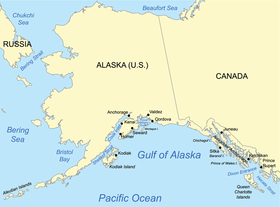Gulf of Alaska
The coast is heavily indented with Cook Inlet and Prince William Sound, the two largest connected bodies of water.
Lituya Bay (a fjord north of Cross Sound, and south of Mount Fairweather) is the site of the largest recorded tsunami in history.
The Gulf of Alaska is considered a Class I, productive ecosystem with more than 300 grams of carbon per square meter per year[2] based on SeaWiFS data.
In 1977, the Gulf of Alaska started to manifest an unexpected and at that time inexplicable shift on its normal climate regime, resulting in a growth of the mean temperature of the sea surface and in an increased availability and variety of commercial fish species.
The US Geological Survey's Geographic Names Information System database defines the Gulf of Alaska as bounded on the north by the coast of Alaska and on the south by a line running from the south end of Kodiak Island on the west to Dixon Entrance on the east.
